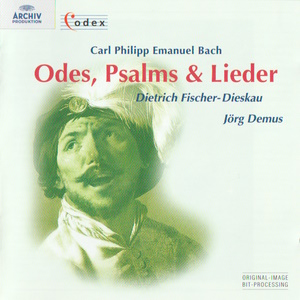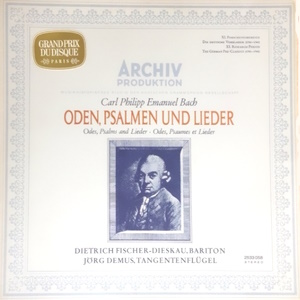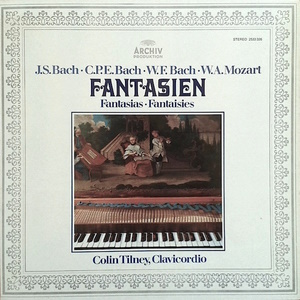 |
|
1 CD -
453 168-2 - (p) 1996
|
|
50
Jahre (1947-1997) - Codex I Serie - 7/10
|
|
|
|
|
|
|
|
ODES, PSALMS
& LIEDER
|
|
|
|
|
|
|
|
Carl
Philipp Emanuel BACH (1714-1788)
|
Über
die Finsternis kurz vor dem Tod
Jesu, Wq 197 |
|
2' 14" |
1
|
|
Der
Frühling, Wq 197
|
|
1' 44" |
2 |
|
Pröfung
am Abend, Wq 194
|
|
4' 06" |
3 |
|
Morgengesang,
Wq 194
|
|
1' 56"
|
4 |
|
Bitten,
Wq 194
|
|
1' 27" |
5 |
|
Trost
der Erlösung, Wq 194
|
|
1' 39" |
6 |
|
Fantasia
in C minor, Wq 63, 6 ("Probestück")
*
|
|
5' 47" |
7 |
|
Passionslied,
Wq 194
|
|
5' 36" |
8 |
|
Die
Güte Gottes, Wq 194
|
|
2' 03" |
9 |
|
Abendlied,
Wq 194
|
|
2' 12" |
10 |
|
Wieder
den Übermut, Wq 194
|
|
3' 50"
|
11 |
|
Demut,
Wq 194
|
|
2' 19" |
12 |
|
Fantasia
in C major, Wq 61, 6 *
|
|
6' 17" |
13 |
|
Der
19. Psalm, Wq 196
|
|
2' 04" |
14 |
|
Der
130. Psalm, Wq 196 |
|
2' 28" |
15 |
|
Weihnachtslied,
Wq 197
|
|
2' 26" |
16 |
|
Jesus
in Gethsemane, Wq 198
|
|
3' 26" |
17 |
|
Der
Tag des Weltgerichts, Wq 197
|
|
2' 19" |
18 |
|
Der
148. Psalm, Wq 196 |
|
0' 52" |
19 |
|
|
|
|
Dietrich
FISCHER-DIESKAU, baritone
Jörg DEMUS, tangent
piano (Tangentenflügel)
Colin TILNEY, clavichord
*
|
Extracts from the
collections:
- Herrn Professor Gellerts Geistliche
Oden und Lieder mit Melodien, Berlin
1958 (Wq 194)
- Herrn Doctor Cramers übersetzte
Psalmen mit Melodien zum Singen bey
dem Claviere, Leipzig 1774 (Wq 196)
- Herrn Christoph Christian Sturms,
Hauptpastors an der Hauptkirche St.
Petri und Scholarchen in Hamburg,
Geistliche Gesänge mit Melodien zum
Singen bz dem Claviere, Hamburg 1780
(Wq 197) / Zweyte Sammlung, Hamburg
1781 (Wq 198)
- Clavier-Sonaten und freye Fantasien,
nebst einigen Rondos für Fortepiano
für Kenner und Liebhaber, 66.
Sammlung, Hamburg 1786 (Wq 61, 6)
18 Probestücke in 6 Sonaten. Beigabe
zum Versuch über die wahre Art, das
Clavier zu Spielen. Teil 1, Berlin
1753 (Wq 63, 6)
Publishers:
- C.P.E. Bach, 30 geistliche Lieder:
Edition Peters, ed. H. Roth;
- Fantasias: Breitkopf & Härtel,
ed. L. Hoffmann-Erbrecht
|
|
|
|
|
Luogo
e data di registrazione |
|
St.-Michaelis-Heim,
Berlin-Grunewald (Germania) -
20-22 novembre 1969 (Odes)
Studio Hamburg, Hamburg-Rahlstedt
(Germania) - 1-5 dicembre 1975
(Fantasias)
|
|
|
Original
Editions |
|
-
Archiv Produktion | 2533 058 | 1
LP | (p) 1971 | ANA | (Odes)
- Archiv Produktion | 2533 326 | 1
LP | (p) 1976 | ANA | (Fantasias)
|
|
|
Edizione
"Codex"
|
|
Archiv
Produktion "Codex" | 453 168-2 |
durata 55' 00" | LC 0113 | 1 CD |
(p) 1996 | ADD | stereo
|
|
|
Executive
Producer |
|
Rainer
Brock (Odes); Dr. Andreas
Holschneider (Fantasias)
|
|
|
Recording
Producer and Tonmeister |
|
Hans-Peter
Schweigmann (Odes); Heinz
Wildhagen (Fantasias)
|
|
|
Cover |
|
Hendrick
Ter Brugghen "Duo" (detail),
Louvre, Paris
|
|
|
Art Direction
|
|
Fred
Münzmaier
|
|
|
Note |
|
Original-Image-Bit-Processing
- Added presence and brilliance,
greater spatial definition |
|
|
|
|
|
ORIGINAL
EDITIONS

1 LP - 2533 058 - (p) 1971
 1 LP - 2533 326 -
(p) 1976
1 LP - 2533 326 -
(p) 1976
|
Treasures
from Archiv Produktion’s
Catalogue
A rare and valuable collection of
documents is the pride of any
library or archive. CODEX, Archiv
Produktion’s new series, presents
rare documents in sound from 50
years of pioneering recording.
These recordings have been
digitally remastered using
original-image bit-processing
technology and can now be
appreciated in all the richness of
their original sound-image. They
range from the serene counterpoint
of a Machaut, the intensely
spiritual polyphony of a Victoria,
to the imposing state-music of a
Handel.
For the artists on Archiv
Produktion recordings, a constant
aim has been to rediscover the
musical pulse of past times and to
recreate the spirit of past ages.
In this sense each performance
here - whether by Pro Musica
Antiqua of Brussels in the 1950s,
the Regensburg Domchor in the
1960s, or Kenneth Gilbert and
Trevor Pinnock in the 1970s - made
a vital contribution to the
revival of Early Music in our
time.
CODEX highlights recordings that
were unique in their day, many of
them first recordings ever of this
rare and remarkable repertoire,
now appearing for the first time on
CD. A special aspect of the
history of performance in our
century can now be revisited, as
great moments from Archiv
Produktion’s recording history are
restored and experienced afresh.
Dr.
Peter Czornyi
Director,
Archiv Produktion
“... He has succeeded in
investing these brief song
settings with a very real
significance”
Carl Philipp Emanuel Bach’s songs
had long since ceased to be part
of the general musical
consciousness when the leading
Swiss composer and teacher, Hans
Georg Nägeli, contributed a
generous assessment of them to the
Allgemeine musikaliscbe Zeitung
in 1811: “As experienced as any
other in the scientific branch of
art and as accomplished in the
artistic branch, while at the same
time incomparably intelligent and
imaginative, he [Carl Philipp
Emanuel Bach] has succeeded in
investing these brief song
settings with a very real
significance that even today’s song
composers would seek in vain to
surpass.” Even as Nägeli was
penning these lines, Franz
Schubert was setting the first of
his 600 lieder, Schiller’s Der
Mädchen Klage.
Nägeli rightly draws attention to
the singularity and originality of
Bach’s songs. The composer’s first
such collection - a setting of
Christian Fürchtegott Gellert’s
anthology of sacred odes and hymns
- appeared in 1758, amid the
depredations of the Seven Years
War. Published under the title Herrn
Professor Gellerts geistliche
Oden und Lieder mit Melodien,
it turned him overnight into one
of Germany’s most highly regarded
song composers. The fact that the
edition was reprinted no fewer
than five times during its
composer’s lifetime is in itself
sufficient to underline the
extraordinary popularity of these
Gellert settings.
Berlin was the centre of the
German art song in the years
around 1750. Agricola, Kirnberger,
Marpurg, Quantz and Carl Philipp
Emanuel himself were only the most
prolific of the many composers who
turned, by preference, to the
poetry of Gellert, Hagedorn,
Gleim, Gräfe, Ramler and Lessing.
The majority of their songs were
secular in character and,
technically speaking, relatively
simple, so that amateur musicians
could easily sing them. The
Gellert songs, by contrast, are
rather more demanding, as is clear
from a review that appeared in the
Allgemeine Deutsche Bibliothek
in 1766: “Nor is there any
mistaking Mr. Bach’s fiery and
imaginative spirit in these odes.
Although they really seem to have
been conceived more in terms of
the keyboard than the voice, a
well-trained and technically
competent singer will none the
less find ample opportunity to
improve his or her execution of
small ornaments, to practise the
accurate rendition of certain
difficult melodic configurations
and, in general, to develop his or
her powers of expression.”
Influenced, as he was, by
Pietistic ideas, Bach wrote these
songs with the specific aim of
being both edifying and
instructive. In Bitten,
the setting of the text is largely
syllabic, with only a few
significant exceptions. The words
“so weit die Wolken gehen” (as far
as the clouds go) are set
melismatically, no doubt in an
attempt to underscore the poetic
image, while the sense of contrast
contained within the strophe as a
whole, notably at the words “Herr,
meine Burg, mein Fels” (Lord, my
fortress, my rock), is reflected
in the detailed musical setting,
with its emphatic repeated notes
underscored by agitated
accompanying figures and firmly
anchored in G major, before the
music abruptly modulates back to
the opening key of E minor at the
words “Vernimm mein Flehn" (Hear
my entreaty) and finally dies away
on a rapt pianissimo.
Almost 50 years later Beethoven
would adopt a totally different
series of compositional solutions
when setting this same poem. But
that he was familiar with Bach’s
version is beyond question, so
striking are the parallels between
individual passages.
Bach‘s close collaboration with
his various poets lasted many
years and continued to bear fruit
during his years in Hamburg. Time
and again, however, it was the
poets of the Göttinger Hain - a
league of student-poets enamoured
of Klopstock’s new and emotional
brand of poetry - to whom the much
older composer returned and who,
in turn, approved of his manner of
setting their poems. Bach not only
wrote many secular songs, some of
which are almost popular in tone,
he also composed numerous sacred
songs. In 1774 he published, at
his own expense, Herrn Doctor
Cramers übersetzte Psalmen mil
Melodien zum Singen bey dem
Claviere (Dr. Cramers Psalms
in Translation, with Melodies to
Sing at the Keyboard), settings of
words by the Kiel professor of
theology, Johann Andreas Cramer.
Bach’s ability to capture the tone
of contemporary Empfindsamkeit
is clear from a whole series of
enthusiastic reviews of these
musical miniatures.
When Christoph Christian Sturm was
appointed preacher at St. Peter’s
in Hamburg in 1777, Bach wrote an
introductory piece to welcome him.
Their collaborative Geistliche
Gesange of 1780 and 1781
were so successful that no fewer
than 224 printed copies of the
first part were ordered in Hamburg
alone. In her authoritative study
of Bach’s songs, Gudrun Busch
offers an admirable assessment of
both collections: “Experimentation
and a conscious desire to be
different are avoided. All this
reflects the contemplative
religiosity of Sturm’s texts. The
most powerful expressivity is
concentrated in the highly
successful Passion hymns, which
provide further evidence of Bachs
distinctive style in terms of
chromaticism, harmonic writing and
declamation.”
At the same time that he was
devoting his creative energies to
songs such as these, with their
profoundly internalized moods,
Bach was also writing highly
virtuoso keyboard music. The
fantasia offered him the
possibility, as he himself said,
to express the changes “from one
affect to another with surprising
speed”. As a “trial effort” he did
this out for the first time in 1753
in the C minor Fantasia included
in his Versusch über die wahre
Art, das Clawier zu spielen
(“Essay on the True Art of Playing
Keyboard Instruments”). Thirty
years later, in his collections
“for connoisseurs and amateurs”,
he returned to the genre. The
expressive contrasts found in the
C major Fantasia from the sixth
collection could hardly be more
extreme and inevitably recall
Reichardt’s description of Bach
as a “serious humorist”.
Hans-Günter
Ottenberg
(Translation:
Stewart Spencer)
The Instruments
The tangent piano (Tangentenflügel)
is a keyboard instrument of the
18th century. Its position within
the history of the keyboard
instruments is between the
clavichord and the fortepiano. The
first types of the Tangentenflügel
produced their sound like the
clavichord, but the shape of the
“tangent” at the rear end of the
keys was different: instead of the
vertical brass blade there was a
jack-shaped wooden pin to strike
the string. While the strings of
the clavichord are set up at right
angles to the keyboard, those of
the Tangentenflügel are
arranged in a line with the
relevant finger-keys and give the
instrument the shape of a grand
piano. This had already been the
shape of the harpsichord, and it
prevailed in the further
development of the keyboard
instruments (from the different
kinds of the hammerklavier to the
grand piano of today). In the
course of the 18th century the
mechanism of the Tangentenflügel
was refined, among others by
Christoph Gottlieb Schröter of
Dresden, but only towards the end
of the century did the instrument
gain some popularity for its “very
strong and sumptuous sound”
(Heinrich Christoph Koch, Musikalisches
Lexikon, Frankfurt-on-Main,
1802, p. 1493). The sound was now
produced by a tangent made of wood
(also later covered with leather)
striking the string by means of an
intermediate lever, a second
wooden pin attached at the rear
end of the key muted the string.
This mechanism was also used by
Franz Jakob Späth and Christoph
Friedrich Schmahl of Regensburg
who made Tangemtenflügel
from about 1751 to 1812. The Tangentenglügel
used in this recording was made by
them in 1793. The instrument was
loaned by the Museum of Musical
Instruments of the State Institute
for Musical Research, Preussischer
Kulturbesitz, Berlin.
The clavichord heard in this
recording was made by Hieronymus
Albrecht Hass, Hamburg, in 1742.
Hass (1721-85) came from a
well-known Hamburg family of
instrument makers who concentrated
almost exclusively on the
production of keyboard instruments
and are known to have maintained a
workshop in Dresden as well as in
Hamburg.
The instrument is an unfretted
clavichord with a compass of five
octaves (F1-f3). From F1-d there
are three unison strings to a
note, from d#-f3 pairs of strings.
In 1953 the instrument was
restored by Hans Lengemann. Then,
in 1975, a complete examination
and restoration was carried out by
Martin Skowroneck of Bremen.
During restoration in 1975 the
strings were replaced completely;
those now used are composed of a
copper alloy.
Archiv Produktion wishes the thank
the Museum für Hamburgische
Geschichte for the loan of this
valuable instrument, and Frau Dr.
Gisela Jaacks for her help and
co-operation.
For technical resasons, the
transfer has been made at a high
level. In order to obtain natural
reproduction corresponding to the
original quiet sound, the volume
should be turned down as low as
possible.
|
|
|
|